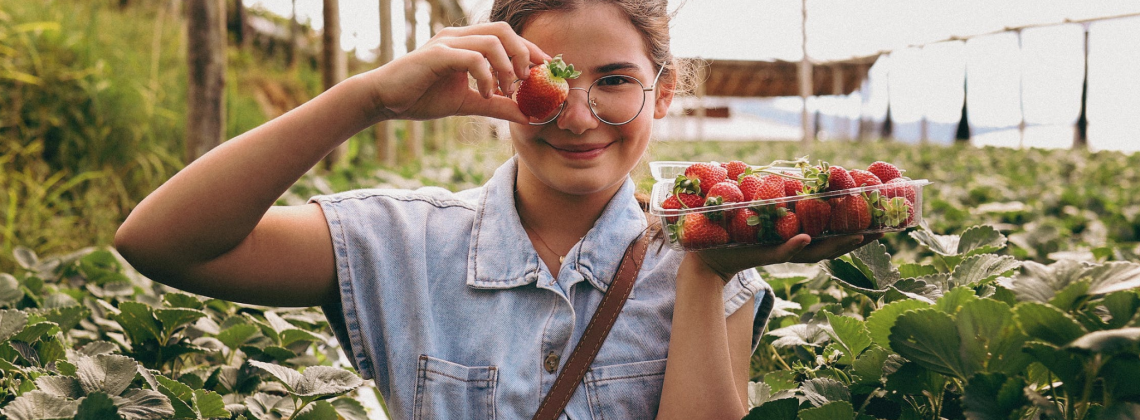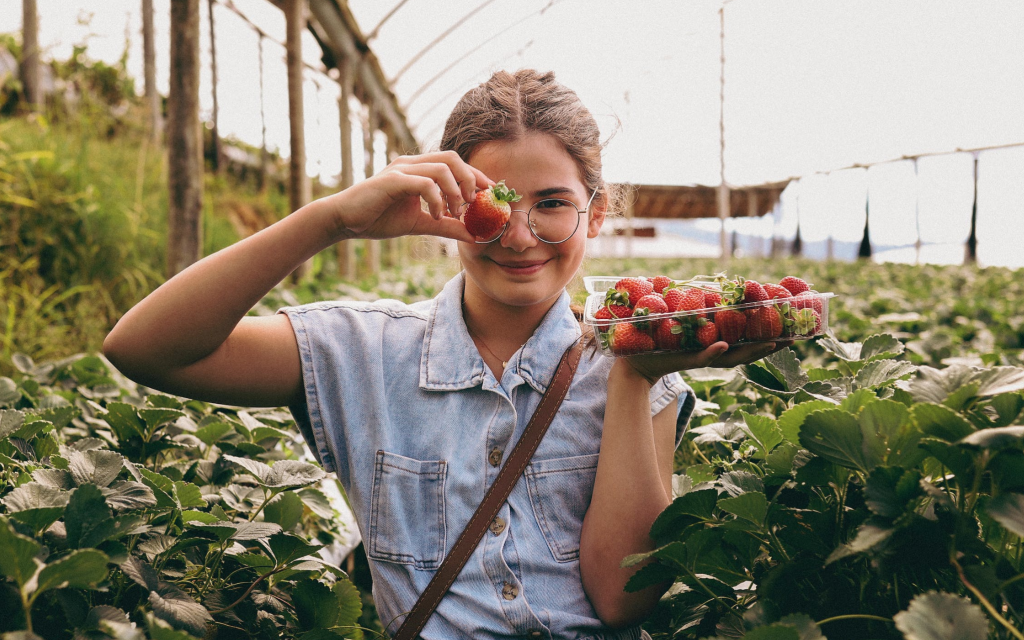

June is strawberries. Blueberries are July. In August the raspberries ripen.
In summer I go berry picking. I have done it as long as I can remember, beginning with my mother taking my brothers, sisters, and me to farms where we grew up in upstate New York. We picked other things too, sometimes cherries, peas, or green beans. But berries above all signaled summer. Abundant, jewel-bright, short of season and shelf-life, lost unless eaten immediately or put up in jam jars: nothing else announced so clearly our dependence on season and weather for the fruit of the earth. We only ate strawberries in the summer when I was growing up because grocery stores seldom had them in winter and we couldn’t afford them. They also weren’t very good.
There is no other way to get fragile, perishable berries except to pick them yourself, and no way to get them in the quantities appropriate to families with young, hungry households than to have children pick them too. As a child and as an adult I thought picking was fun, though there’s a line—jagged like the straw between rows—that divides picking for pleasure from plain labor. When it’s not your job, picking berries is fun, something to do on a summer day. We could stop when we had as many berries as we wanted, and whatever our hands got was ours to eat. Picking can be like a game since it takes more effort than buying the pre-picked boxes and includes the thrill of the hunt, the never-ending search for the best ones. My brother was good at finding the very best ones; when he shouted “gold mine” down the row we would come to admire the trove in his green quart basket.
Berry picking is very small participation in the labor of farming, harvesting by our own hands what to eat at our table. My mother was wont to point out all the effort farmers did before we arrived: setting the plants, scattering the straw, watering and weeding until the berries became ready. We gathered where we did not plant. Others labored and we joined their harvest.
When you arrive at a strawberry field you walk all the way to the end of the row where you start, fitting your feet in troughs between the lines of plants. You must stop your senses to the blandishments of the berries you see on the way, flashes of red tempting you to bend down and try one or two before you get to where you start. Some farms manage fields with stiff regulations, attendants making you start here or there as marked with a flag, shooing when you stray from your row to berries clustered in another. You don’t pick a row someone else already has begun. I go picking in the morning before the heat of the day, early but not too early. Other pickers, mostly women, have arrived already before me. Competitiveness with other pickers is inevitable but fleeting. I envy the full baskets toted by early arrivers when mine are empty, but I see plenty more fruit and I get to work.
To start, you crouch down in the furrow between the plants and pick one side and then the other. Sometimes berries shine out, wanting to be found. More often you have to reach under the leaves for a bunch at the bottom. The big berries look best, but they go bad first. They weigh down the stems, getting their tips stuck in the dirt. The giant berries are more often the ones with the worm hole or rotten spot on the underside (with fruit imitating life). The farmhands tell you, “The little ones are the sweetest,” a well-intended but false appeal to the conscientious picker. Of course you should pick the little ones too. Of course they are good, and if the box is paid by volume, little ones will get you more for the same quart price. Also it’s more efficient to pick the cluster clean and fill baskets with the variety nature gives. But the unblemished big ones are prizes, round like apples, or heart-shaped, or oblong pairs fused together, or the kind with big shoulders, or the kind where the pale neck reaches to leaf cap. The little ones are good, but the big ones fill the mouth when you eat them, warm from the field and full of juice, sweet with tang and stain and the sandy crunch of seeds.
To eat or not to eat, that is the question. When harvesting a row, one wonders whether tis better to wait and wash and slice and eat at home, whether picking will be more efficient without tarrying for samples, whether it is theft to eat what hasn’t been weighed and paid for. Eat, of course eat. My aunt, after she got born again, used to accuse my mother of letting us steal. An excellent casuist, my mother said the berry farm expected us to eat some, that they figured our eating into the price, and that we weren’t eating that many anyway. Once she offered to let the farmhand weigh us on way in and out and promised to pay the difference.
I have taken my own kids to pick berries since they were small. On these outings to the lovely farms of the Massachusetts North Shore, I sometimes overheard other moms tell their children not to eat any because berries were sprayed and needed to be taken home and washed first. Sad. Some of these farms directed moms and kids to special family patches. This was a shame rather than an honor because the less nice rows were conceded to the trampling and indiscriminate grasping feared from young children. I respect farmers’ cautions. Farmers have to protect their crops. But one of my proudest moments as a mother was when Farmer Bob waved on the bunch of us, a few kids under ten and me, into the regular patch.
When strawberries run out, there are other berries to pick. Blueberries grow on high bushes in clumps. Here in Indiana, berry patches show up between cornfields. You can grab whole handfuls of big purplish-blue fruit, with pale powder-wax coating, some the size of marbles. The big ones really are best. Blueberries are beautiful in full buckets, bouncy and hard to contain. Raspberries need care. With each reach, one is prone to catching sleeve or skin on thorns. Ripe berries practically fall off the receptacle when touched, and bees often hover around. Raspberries are worth the effort, velvety and bosky, and even quicker to spoil than strawberries. Wild berries can be found too: black raspberries in suburban hedgerows or beside railroad tracks.
Picking berries leads to eating berries. As a kid I ate them in the car on the way home from the farm, from the tray in the open refrigerator, or in morning cereal, pink or purple swirling through the milk. Now when there are berries that my children and I have picked, we eat shortcake every day until the berries are gone—sometimes at (as?) all three meals.
Agnes R. Howard teaches in Christ College, the honors college at Valparaiso University, and is author of Showing: What Pregnancy Tells Us about Being Human. She is a Contributing Editor for Current.